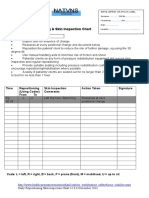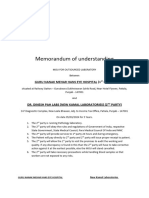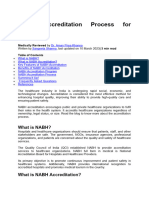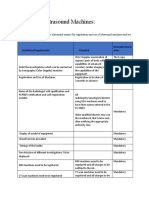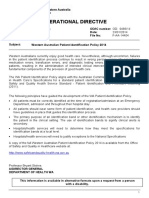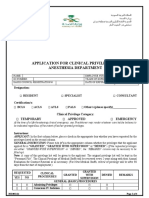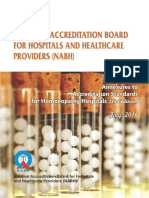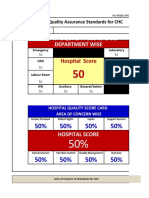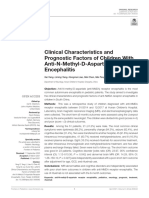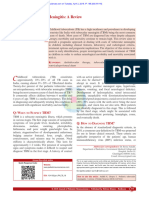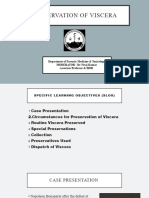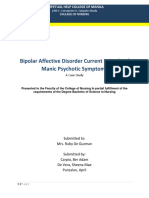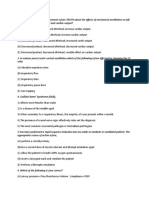0 ratings0% found this document useful (0 votes)
2K viewsLumbar Puncture Consent Form
Lumbar Puncture Consent Form
Uploaded by
Jann Adriel Chua SyA lumbar puncture, also known as a spinal tap, is a procedure where a needle is inserted into the lower back to collect cerebrospinal fluid from the spinal canal for diagnostic testing. It is most commonly performed to test for infections or the presence of cancer cells. During the procedure, the patient lies on their side while local anesthesia is administered and a needle is inserted between two lumbar vertebrae. Potential risks include temporary back pain, headache, bleeding, and very rarely, infection or neurological complications.
Copyright:
© All Rights Reserved
Available Formats
Download as PDF, TXT or read online from Scribd
Lumbar Puncture Consent Form
Lumbar Puncture Consent Form
Uploaded by
Jann Adriel Chua Sy0 ratings0% found this document useful (0 votes)
2K views2 pagesA lumbar puncture, also known as a spinal tap, is a procedure where a needle is inserted into the lower back to collect cerebrospinal fluid from the spinal canal for diagnostic testing. It is most commonly performed to test for infections or the presence of cancer cells. During the procedure, the patient lies on their side while local anesthesia is administered and a needle is inserted between two lumbar vertebrae. Potential risks include temporary back pain, headache, bleeding, and very rarely, infection or neurological complications.
Original Title
Lumbar Puncture Consent Form Copy
Copyright
© © All Rights Reserved
Available Formats
PDF, TXT or read online from Scribd
Share this document
Did you find this document useful?
Is this content inappropriate?
A lumbar puncture, also known as a spinal tap, is a procedure where a needle is inserted into the lower back to collect cerebrospinal fluid from the spinal canal for diagnostic testing. It is most commonly performed to test for infections or the presence of cancer cells. During the procedure, the patient lies on their side while local anesthesia is administered and a needle is inserted between two lumbar vertebrae. Potential risks include temporary back pain, headache, bleeding, and very rarely, infection or neurological complications.
Copyright:
© All Rights Reserved
Available Formats
Download as PDF, TXT or read online from Scribd
Download as pdf or txt
0 ratings0% found this document useful (0 votes)
2K views2 pagesLumbar Puncture Consent Form
Lumbar Puncture Consent Form
Uploaded by
Jann Adriel Chua SyA lumbar puncture, also known as a spinal tap, is a procedure where a needle is inserted into the lower back to collect cerebrospinal fluid from the spinal canal for diagnostic testing. It is most commonly performed to test for infections or the presence of cancer cells. During the procedure, the patient lies on their side while local anesthesia is administered and a needle is inserted between two lumbar vertebrae. Potential risks include temporary back pain, headache, bleeding, and very rarely, infection or neurological complications.
Copyright:
© All Rights Reserved
Available Formats
Download as PDF, TXT or read online from Scribd
Download as pdf or txt
You are on page 1of 2
Lumbar Puncture
(Affix Patient Label)
What is a lumbar puncture?
A lumbar puncture is the insertion of a needle into the fluid space within the spinal canal. It is termed a
lumbar puncture because the needle goes into the lower back called the lumbar area.
Why is this done?
A lumbar puncture is most commonly done for diagnostic purposes, namely to obtain a sample of the
fluid in the spinal canal (cerebrospinal fluid) for tests to detect infection and/ or presence of cancer cells.
How is this procedure performed?
You will most commonly be lying down sideways for the procedure. After local anaesthesia is injected
into the lumber area, a needle is inserted in between the bony blocks (vertebrae) into the spinal canal.
The needle is usually placed between the 3
rd
and 4
th
lumbar vertebrae. The spinal fluid pressure can
then be measured. Cerebrospinal fluid is then removed for tests.
What are the risks of a lumbar puncture?
As with any medical procedure, complications may occur. Some of the most common and important
complications following lumbar puncture are:
Backache
Headache
Bleeding
Infection
Neurological deterioration
Backache
The doctor will numb the skin of your lower back before insertion of the needle. However, mild lower
back discomfort, generally lasting one or two days, might still occur. This is easily treated with simple
pain medications.
Headache
Occasionally, a headache follows lumbar puncture. This is the most common complication following a
lumbar puncture, but occurs in less than one of ten procedures. The headache can occur from hours up
to a day or so after the procedure. Remaining recumbent and avoiding walking until six hours after the
procedure may reduce the likelihood of headache. Drinking adequate water may also help reduce the
incidence or severity of headaches. Pain medications can usually relieve the headache.
Bleeding
As with any procedure involving puncture with a needle, bleeding may occur at the procedure site.
Bleeding is usually minimal in lumbar puncture, except when disorders of the blood clotting system are
present. Occasionally a blood clot that has formed under the skin at the site of the procedure called a
haematoma may cause prolonged pain. The risk of this happening can be reduced by lying flat for six
hours after the procedure.
Infection
Rarely, an infection may develop at the procedure site. In order to reduce the chances of infection, the
skin of your lower back will be cleaned with a sterilizing agent. However, it is possible that infection may
still occur.
To be continued on the next page
Neurological deterioration
In very rare situations, neurological deterioration may follow lumbar puncture. This only occurs if the
cerebrospinal fluid pressure is high and becomes reduced during the procedure, causing a part of the
brain to sink into an area of the skull resulting in coma and possible life-threatening event. The chance of
any such adverse change developing can be assessed by clinical examination and/ or radiological
procedures performed prior to the lumbar puncture.
Others (to be filled by Medical Practitioner)
Acknowledgement Section
Part I To Be Filled by Patient
I have read and understood the potential complication(s) that can arise from the surgery.
I acknowledge that the complication(s) listed are not intended to be exhaustive. I have had an
opportunity to ask for more information about any of the above-mentioned complications, as well as the
risks in general, or any specific condition of concern to me.
Part II To Be Filled by Medical Practitioner
I confirm that I have explained the reason for and the nature of potential complication(s) that may arise
from the procedure to the patient and the above-named witness.
Part III To Be Filled by Interpreter (if applicable)
I, _____________________________confirm that I have explained to the patient the reason for and the
nature of potential complication(s) that may arise from the procedure in _______________________.
* Please delete accordingly
(*Signature/Thumbprint(*Right/Left) of
*Patient/ Parent/ Guardian/ Next of kin)
(Name & NRIC of *Patient/Parent/
Guardian/Next of kin)
(Designation of Witness) (Name of Witness)
(Date of Signing) (Signature of Witness)
(Name & Signature of Medical Practitioner) (Date of Signing)
(Name of Interpreter)
(*Language / Dialect)
(Date of Signing) (Signature of Interpreter)
You might also like
- Neuroradiology Companion Methods Guidelines and Imaging Fundamentals Zamor PDFDocument1,764 pagesNeuroradiology Companion Methods Guidelines and Imaging Fundamentals Zamor PDFCoralina100% (3)
- Training: Medical Kpis in Hemodialysis Nephrocare Balance Score Card & Medical Patient ReviewDocument16 pagesTraining: Medical Kpis in Hemodialysis Nephrocare Balance Score Card & Medical Patient ReviewSoraia AveiroNo ratings yet
- Daily Repositioning Skin Inspection ChartDocument2 pagesDaily Repositioning Skin Inspection Chartsafasayed100% (1)
- Nbme Step 1 AnatomyDocument23 pagesNbme Step 1 AnatomyMohsin Farooq100% (13)
- AlzheimerDocument11 pagesAlzheimerSoniya G08No ratings yet
- NCM 106 Acute Biologic CrisisDocument142 pagesNCM 106 Acute Biologic CrisisEllamae Chua88% (8)
- Effective CommunicationDocument11 pagesEffective CommunicationEsamNo ratings yet
- Hospitalist Program Toolkit: A Comprehensive Guide to Implementation of Successful Hospitalist ProgramsFrom EverandHospitalist Program Toolkit: A Comprehensive Guide to Implementation of Successful Hospitalist ProgramsNo ratings yet
- Session 4Document3 pagesSession 4Sistine Rose Labajo100% (2)
- Cases in Primary Care - NEJMGroup - CollectionDocument146 pagesCases in Primary Care - NEJMGroup - CollectionPanayiotis Stavroulakis100% (3)
- Case Study MeningitisDocument22 pagesCase Study MeningitisHannah Faith100% (1)
- Consent For Laparoscopic Hysterectomy EnglishDocument4 pagesConsent For Laparoscopic Hysterectomy EnglishGaurav AroraNo ratings yet
- Nosocomial Infection: Presented By, Saima Fazal B.S (3 Year)Document28 pagesNosocomial Infection: Presented By, Saima Fazal B.S (3 Year)samer falconNo ratings yet
- How To Move The Patient From The Bed To The Wheelchair How To Move The Patient From The Bed To The WheelchairDocument9 pagesHow To Move The Patient From The Bed To The Wheelchair How To Move The Patient From The Bed To The WheelchairAfniy ApriliaNo ratings yet
- Primary Health Care Centre (PHCC)Document6 pagesPrimary Health Care Centre (PHCC)radha poudelNo ratings yet
- MOU FOR LAB Outsourced 07022023Document2 pagesMOU FOR LAB Outsourced 07022023DR JASPRIT SINGH HANSNo ratings yet
- JD Ward Clerk Job DescriptionDocument2 pagesJD Ward Clerk Job DescriptionMD Luthfy LubisNo ratings yet
- Mews ScoreDocument13 pagesMews Score2009nicoleta100% (2)
- Checklist For CLABSIDocument1 pageChecklist For CLABSIpuspitawatiNo ratings yet
- Nursing CompetencyDocument3 pagesNursing Competencyjerimiah_manzonNo ratings yet
- Prescription AuditDocument1 pagePrescription AudituhckkrNo ratings yet
- NABHDocument6 pagesNABHllbbhagyashreeNo ratings yet
- NABH GuideDocument140 pagesNABH GuideavmrNo ratings yet
- 2017 Syllabus - MVH Modular Sedation SeriesDocument11 pages2017 Syllabus - MVH Modular Sedation SeriesyalahopaNo ratings yet
- Guidelines For Registraton and Use of Ultrasound MachineDocument6 pagesGuidelines For Registraton and Use of Ultrasound MachineHimanshu GuptaNo ratings yet
- Missing Patients ProcedureDocument16 pagesMissing Patients ProcedureAgnieszka WaligóraNo ratings yet
- Western Australian Patient Identification Policy PDFDocument14 pagesWestern Australian Patient Identification Policy PDFpuspadiniaNo ratings yet
- The Critical-Care Pain Observation Tool (CPOT) : Indicator Score DescriptionDocument6 pagesThe Critical-Care Pain Observation Tool (CPOT) : Indicator Score DescriptioncignalNo ratings yet
- A P Policy & Procedure: Ntibiotic OlicyDocument24 pagesA P Policy & Procedure: Ntibiotic Olicyvijay kumarNo ratings yet
- Nurs478 Quality Improvement Project FinalDocument14 pagesNurs478 Quality Improvement Project Finalapi-707959545No ratings yet
- AIOS Consent Forms Hindi EnglishDocument194 pagesAIOS Consent Forms Hindi EnglishNarendra PandaNo ratings yet
- Management of Head Injury in Primary CareDocument77 pagesManagement of Head Injury in Primary CareChidi MbatuegwuNo ratings yet
- Managing An Outbreak of Postoperative Endophthalmitis PDFDocument12 pagesManaging An Outbreak of Postoperative Endophthalmitis PDFNawang cpsNo ratings yet
- Obtaining Valid Consent: Clinical Governance Advice No. 6Document9 pagesObtaining Valid Consent: Clinical Governance Advice No. 6Ywagar YwagarNo ratings yet
- ED Patient Safety Checklist in Word v1.2 I6waMNEDocument2 pagesED Patient Safety Checklist in Word v1.2 I6waMNEno oneNo ratings yet
- Medical ErrorDocument75 pagesMedical ErrorVanessa Sugar Syjongtian SiquianNo ratings yet
- PRESENTATION 1. Grieviance Redressal CommitteeDocument25 pagesPRESENTATION 1. Grieviance Redressal CommitteeBAHHEP BAHHEPNo ratings yet
- Minimal Moderate Sedation StandardsDocument59 pagesMinimal Moderate Sedation StandardsSheila JuddNo ratings yet
- Hospital Formulary: Page - 0Document11 pagesHospital Formulary: Page - 0Joeren GonzalesNo ratings yet
- MSDS DR - DR - Disinfectant Multi Enzyme Detergent1Document4 pagesMSDS DR - DR - Disinfectant Multi Enzyme Detergent1ralothaimeen.mohNo ratings yet
- Sedation ScaleDocument3 pagesSedation ScaleDurjoy_Sarker_1434No ratings yet
- Obeid Specialized Hospital - Riyadh: Inpatient DeptsDocument4 pagesObeid Specialized Hospital - Riyadh: Inpatient DeptsLovelydePerioNo ratings yet
- KHG - Employee Handbook - External 2022Document32 pagesKHG - Employee Handbook - External 2022annsheliann9No ratings yet
- Catheterisation Standard Operating ProcedureDocument27 pagesCatheterisation Standard Operating ProcedureSherly RositaNo ratings yet
- Obeid Specialized Hospital - Riyadh: Key Performance Indiactors Second Quarter - 2019Document29 pagesObeid Specialized Hospital - Riyadh: Key Performance Indiactors Second Quarter - 2019LovelydePerioNo ratings yet
- Cleaning of OtDocument7 pagesCleaning of Otvinod balajiNo ratings yet
- Konferensi PerawatDocument159 pagesKonferensi PerawatdroenNo ratings yet
- Environmental SurveillanceDocument11 pagesEnvironmental Surveillancedr rajoreNo ratings yet
- ER Policies - ProceduresDocument42 pagesER Policies - Proceduressamora mostafaNo ratings yet
- 208-Audit Checklist-Autoclave Operation - FinalDocument6 pages208-Audit Checklist-Autoclave Operation - FinalCherry Hope MistioNo ratings yet
- Minutes of The Infection Control Committee MeetingDocument3 pagesMinutes of The Infection Control Committee Meetingnana100% (1)
- Infection-Prevention-Control HDFDocument15 pagesInfection-Prevention-Control HDFArlene AngelesNo ratings yet
- Budgets For Nabh 2020-21Document3 pagesBudgets For Nabh 2020-21narayanreshma8100% (1)
- Pre and Post TestDocument3 pagesPre and Post TestNurhayatiNo ratings yet
- Hospital HandbookDocument30 pagesHospital HandbookManuel MunozNo ratings yet
- Access To Care and Continuity of CareDocument44 pagesAccess To Care and Continuity of CareCamille Honeyleith Lanuza FernandoNo ratings yet
- Ms-001 (2) Clinical Privi Form Anesthesia 2019Document4 pagesMs-001 (2) Clinical Privi Form Anesthesia 2019Athira Rajan100% (1)
- Hospital Nabh Final ProjectDocument17 pagesHospital Nabh Final Projectlohithranjan6No ratings yet
- AAC-Entry Level SeriesDocument48 pagesAAC-Entry Level SeriesChandu PanditNo ratings yet
- Scripps Hospital Patient Visitor Policy PDFDocument2 pagesScripps Hospital Patient Visitor Policy PDFcode4saleNo ratings yet
- WHO Surgical Safety ChecklistDocument1 pageWHO Surgical Safety ChecklistArabelle GO100% (1)
- K J Somaiya Hospital & Research Centre: Job DescriptionDocument2 pagesK J Somaiya Hospital & Research Centre: Job DescriptionArpita MishraNo ratings yet
- Homoeopathy Indicators NABHDocument105 pagesHomoeopathy Indicators NABHMamoni MaityNo ratings yet
- Customized NQAS Checklist For Non FRU CHC of OdishaDocument130 pagesCustomized NQAS Checklist For Non FRU CHC of OdishaqaNo ratings yet
- OPD CoordinatorDocument12 pagesOPD Coordinatormedocare loNo ratings yet
- Name: Age: Sex: Date:: Date Ordered Medication-Dose-Route TIM E Date Sign Date Sign Date SignDocument3 pagesName: Age: Sex: Date:: Date Ordered Medication-Dose-Route TIM E Date Sign Date Sign Date SignCezanne CruzNo ratings yet
- Patient Safety Organization A Complete Guide - 2020 EditionFrom EverandPatient Safety Organization A Complete Guide - 2020 EditionNo ratings yet
- Nursing Crib Com NURSING CARE PLAN HydrocephalusDocument3 pagesNursing Crib Com NURSING CARE PLAN HydrocephalusCassandra Grace Labial PaynterNo ratings yet
- PediaDocument3 pagesPediaGenesis MonumentoNo ratings yet
- Physiology of CSFDocument72 pagesPhysiology of CSFtheobudusNo ratings yet
- African Trypanosomiasis African Trypanosomiasis: Sleeping SicknessDocument65 pagesAfrican Trypanosomiasis African Trypanosomiasis: Sleeping SicknessdrgunavetNo ratings yet
- Slide Preparation of Cerebrospinal Fluid For Cytological ExaminationDocument3 pagesSlide Preparation of Cerebrospinal Fluid For Cytological ExaminationMurshed HaidarNo ratings yet
- STENOZA APEDUCTULUI LUI SylviusDocument23 pagesSTENOZA APEDUCTULUI LUI SylviusBogdan ȘtefîrcăNo ratings yet
- 14 The Central Nervous SystemDocument61 pages14 The Central Nervous SystemvanderphysNo ratings yet
- (w14) Nervous Tissue and Nervous SystemDocument7 pages(w14) Nervous Tissue and Nervous Systemden mNo ratings yet
- Clinical Characteristics and Prognostic Factors of Children With Anti-N-Methyl-D-Aspartate Receptor EncephalitisDocument9 pagesClinical Characteristics and Prognostic Factors of Children With Anti-N-Methyl-D-Aspartate Receptor EncephalitisSara IsabelNo ratings yet
- Pediatric Tubercular Meningitis A ReviewDocument10 pagesPediatric Tubercular Meningitis A ReviewemmyNo ratings yet
- Viscera Preservation in Post MortemDocument16 pagesViscera Preservation in Post MortemsagarNo ratings yet
- Atlas of Primary Care Procedures - T Zuber - 2Document880 pagesAtlas of Primary Care Procedures - T Zuber - 2Ali Zainal AbidinNo ratings yet
- A Case Study Bipolar Affective Disorder Current Episode of Manic Psychotic Symptoms (2018)Document45 pagesA Case Study Bipolar Affective Disorder Current Episode of Manic Psychotic Symptoms (2018)april punzalan100% (3)
- Initial Diagnosis and Management of ComaDocument17 pagesInitial Diagnosis and Management of Comaguugle gogleNo ratings yet
- NSGDocument287 pagesNSGjinahyang50% (2)
- Neurological Disorders For BSCDocument276 pagesNeurological Disorders For BSCAdmasu BelayNo ratings yet
- AUBF QuetionsDocument34 pagesAUBF QuetionsAprille Patol100% (1)
- Case Study On Head InjuryDocument15 pagesCase Study On Head InjuryPriya SinghNo ratings yet
- ICU Diploma MCQDocument14 pagesICU Diploma MCQMin Thu Lwin100% (3)
- Assisting With A Lumbar Puncture. 2013Document2 pagesAssisting With A Lumbar Puncture. 2013psychyzeNo ratings yet
- Intrathecal Antibiotic Administration Procedure (Paediatrics)Document9 pagesIntrathecal Antibiotic Administration Procedure (Paediatrics)Abu Azzam Al-HadiNo ratings yet
- m146 PDFDocument697 pagesm146 PDFspgoniNo ratings yet
- Cerebrospinal FluidDocument16 pagesCerebrospinal FluidSolomon Fallah Foa SandyNo ratings yet


